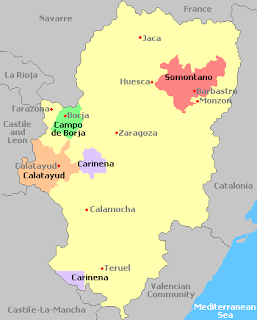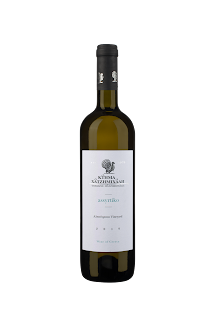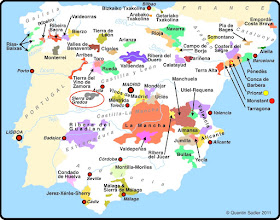Grapevine trunk diseases (GTDs) -- caused by bacterial and/or fungal pathogens -- occur worldwide and, once established in the vineyard, are (i) incurable and (ii) new infections are difficult to control (Morris). Rosace, et al., see these diseases as representing "an emerging and significant problem for Italian vineyards. Among the most common in many viticultural areas in the world and in Europe is esca."
My 2017 report on esca focused on the Guyot-Poussard training system (as promoted by Siminot and Sirch), one of the few preventative approaches in the market at that time. A more comprehensive approach to esca disease management and control has since been advanced. I examine that approach in this post.
Esca History
According to Mugnai, et al., references to esca-like symptoms can be found in several Greek and Latin texts but more precise descriptions can be found in medieval works:
- Kitab al-Felahah by Ibn al-Awani, (a Spanish Muslim who lived in Seville at the end of the 12th century)
- Opus Ruralasium Commodorum by Pietro di Crescenzi (born in Bologna around 1233).
This disease was first successfully controlled in 1903 when sodium arsenite showed its ability to limit esca and other wood diseases. This product was so successful that research on esca essentially came to a halt in 1920.
The first scientific studies on esca were conducted in France and were focused on a disease then known as apoplexy, or folletage, where affected grapevines suddenly withered and did not resume growth thereafter. In 1905, a researcher named Ravaz discovered that a disease with similar symptoms was already known in the region of Smyrna and was called "iska" therein. In the same timeframe, Pierre Viola was informed that folletage was also familiar to the grapegrowers in Squinzana in the Italian province of Lecce; they called it esca. Viola proposed that folletage/apoplexy be heretofore called esca.
In 1926, Viola presented his list of esca symptoms. With the exception of "tiger stripes" all of his indications were eventually reassigned to other diseases.
The accepted symptology of esca that resulted from this first wave of research was wood rot, apoplexy, and chlorosis and necrosis of the leaves. This result was achieved by gradually reducing a superfluity of initial proposed symptoms (Surico).
As mentioned previously, the efficacy of sodium arsenite vis a vis esca had rendered research on the disease moot in the post-1920 period. This changed in 1980 when talk of a potential ban on sodium arsenite began in earnest. The product was deemed to be highly toxic and carcinogenic and was eventually banned in France in 2001 and the rest of Europe in 2003.
The loss of this key anti-esca tool led to second wave (1980 - 2000) of research into the disease. This second wave "has led to a better understanding of the internal symptoms of esca and the etiology of the disease" (Surico). It was determined that:
- The vascular symptoms are directly attributable to the fungi Phaeoacremonium aleophilium and Phaeomoniella chlamydospora
- The main agent that causes woodrot of grapevine is the basidiomycete Formitiporia mediterraneo.
The first international workshop on esca (held in Siena in 1999) led to the formation of new hypotheses on the disease. These hypotheses are illustrated in the chart below.
The current context for esca is shown in the chart below.
Symptoms appear on mature grapevines in vineyards (Úrbanz-Torres, et al.):
- First, symptoms appear as dark red (red cultivars) or yellow (white cultivars) stripes on leaves. These eventually die and become necrotic.
- As the disease progresses, it causes:
- Gray to dark-brown speckling of berries, known as "black measles"
- Sudden wilting of the vines, including shriveling of the fruit that normally occurs in summer and is known as "vine apoplexy"
- A dieback of the entire grapevine.
Economic Impact of Esca
According to Jane Anson, vineyards across Europe has been losing 10 - 20% of their vines to Esca. In France, 11% of total grapevines have been rendered non-productive by esca while Spain saw its affected vineyards increase from 1.8% to 10.5% between 2003 and 2007. The incidence of infection among Central and Southern Italy's older vineyards ranges between 60% and 80% (Body).
Esca Management and Control
Guyot-Poussard Training System
The principle behind the G-P pruning system (or soft pruning, as it is called in some circles) is simple: If pruning wounds are a gateway for pathogen entry into the vine, then let us seek to reduce the number and severity of those wounds. The hypothesis is that the probability of new infections would decline with a reduction in the number and size of pruning wounds.
The soft-pruning method was adopted by Lafon from a training system used in France in the early 20th century and eventually renamed Guyot-Poussard. It has been further refined and evangelized by the Italian duo of Simonit and Sirch who have traveled around the world preaching the benefits of the approach and who train practitioners of the system at their school in Italy.
The system uses small cuts in the upper portions of the cordon to promote continuous horizontal development of adjacent perennial spurs. The small cuts reduce the size of wound desiccation, minimizes the inward-facing size of the desiccation, and, through their placement on the upper part of the structure, leaves unobstructed channels at the lower part of the established structure. The system structure is depicted in the figure below.
According to Infowine, this system:
G-P a la Simonit and Sirch has been implemented in a number of high-profile vineyards to include Domaine Leroy, Ornellaia, Chateau Latour, Haut-Bailly, and Louis Roederer. I have previously mentioned Tenuta du Trinoro and Barboursville Vineyards. According to Delbecque, 60% of the producers in the Sancerrois vineyard have trained their employees in this method while 80% have at least one person competent in this approach.
The principle behind the G-P pruning system (or soft pruning, as it is called in some circles) is simple: If pruning wounds are a gateway for pathogen entry into the vine, then let us seek to reduce the number and severity of those wounds. The hypothesis is that the probability of new infections would decline with a reduction in the number and size of pruning wounds.
The soft-pruning method was adopted by Lafon from a training system used in France in the early 20th century and eventually renamed Guyot-Poussard. It has been further refined and evangelized by the Italian duo of Simonit and Sirch who have traveled around the world preaching the benefits of the approach and who train practitioners of the system at their school in Italy.
The system uses small cuts in the upper portions of the cordon to promote continuous horizontal development of adjacent perennial spurs. The small cuts reduce the size of wound desiccation, minimizes the inward-facing size of the desiccation, and, through their placement on the upper part of the structure, leaves unobstructed channels at the lower part of the established structure. The system structure is depicted in the figure below.
 |
| Illustration of the Guyot-Poussard pruning system. Note the pruning cuts st the top of the cordon allowing the free flow of sap along the bottom portion of the cordon (Source:marceaubourdarias.fr) |
- Reduces the probability of new GTD infections
- Promotes more homogenous development of phenological stages
- Promotes more balanced vegetative growth and more balanced ripening.
- Activities such as shoot removal are more extensive and important in maintenance of the training system
- Leaf removal at flowering and fruit set requires less manpower
- A higher amount of work is required in the early years
- G-P pruning 37.7 hours/ha while traditional takes about 23 hours/ha
- Transition from a traditional to a G-P pruning system will take several years
- G-P a demanding pruning method and requires significant training before implementation.
G-P a la Simonit and Sirch has been implemented in a number of high-profile vineyards to include Domaine Leroy, Ornellaia, Chateau Latour, Haut-Bailly, and Louis Roederer. I have previously mentioned Tenuta du Trinoro and Barboursville Vineyards. According to Delbecque, 60% of the producers in the Sancerrois vineyard have trained their employees in this method while 80% have at least one person competent in this approach.
This approach, however, has been perceived to be too narrow in scope and a more comprehensive model of monitoring and management has been advanced.
Comprehensive Monitoring and Management
Managing the disease requires, firstly, a clear understanding of its parameters. According to Rosace, et al.:
- The disease is spread by spores which can be transported by wind, water splashes, and insect vectors
- Spores can end up on a plant's open wounds (pruning cuts or wounds caused by severe weather), thus spreading the disease in the vineyard (One of the characteristics of traditional pruning systems is numerous large pruning wounds in the grapevine trunk with the potential for (i) intrusion of desiccated material into the interior of the trunk -- and the interruption of sap flow therein -- and (ii) serving as the infection pathway for GTD fungi (Infowine)).
- Fungi can remain dormant in plants for years
- Symptoms can appear in the vineyard inconsistently
Monitoring and managing the disease in the vineyard is, therefore, a complicated issue which is well-served by an integrated approach (Rosace, et al.):
- Good agricultural practices -- helps to prevent infections of the trunk by pathogenic fungi
- Correct planting of new vines
- Choosing the right pruning methods and times
- Disinfecting the tools used during pruning activities on diseased plants
- Correctly managing pruning residues, soil, and irrigation
- Preventive practices
- Use of protective products on pruning wounds
- Pruning sealers
- (bio)fungicides (In recent years fungi of the genus Trichoderma have become popular in protecting wounds)
- Interventions for recovering infected plants
- In the case of diseased plants, curetage has led to positive and significant results in the case of diseased plants
- Removal of diseased wood to save the vine
- Ancient practice
- Pollarding
- Removing fractions of the infected plant until the healthy wood is found.
According to Monis, it is best to prune as late in the season as possible because the vine is more active in the spring and will heal faster. In addition, most fungal trunk disease pathogens release their spores during the rainy seasson thus there will be proportionally fewer spores around in the Spring. Monis also recommends avoiding large pruning wounds, cutting close to the trunk, and pruning after long periods of rain.
Bibliography
Jane Anson, Anson on Thursday: The Prada of Vineyard Pruning, Decanter, 12/10/2015.
Nicolas Body, Esca history and economic impact, alltech.com, 8/8/2019.
Antonio Graniti, et al., Esca of Grapevine: A Disease Complex or a Complex of Diseases, Phytopathologia, 39(1), September 2006.
Judith Monis, Ph.D, Vineyard Fungal Trunk Diseases: Prevention and Control, thegrapevinemagazine.net.
L. Mugnai, A. Graniti, G. Surico, Esca (Black measles) and Brown Wood-Streaking: Two Old and Elusive Diseases of Grapevines, Plant Disease, Vol. 83, No. 5, 1999.
Maria Chiara Rosace, Sara Legler, Vittorio Rossi, An increasing threat to Italian vineyards: Pathogenic fungi and esca complex, 1/15/21, sincerely.it.
Guiseppe Surico, Towards a redefinition of the diseases within the esca complex of grapevines, Phytopathologia Mediterranean, 2009 (48), pp. 5 - 10.
J.R. Úrbaz-Torres, et al., Grapevine Trunk Diseases in British Columbia: Incidence and Characterization of the Fungal Pathogens Associated with Esca and Petri Diseases of Grapevine, Plant Disease, 98(4), April 2014.

























